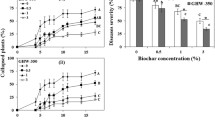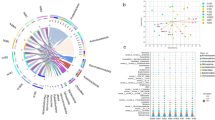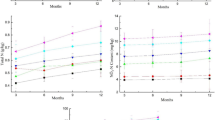Abstract
The impact of additions (1–5% by weight) of a nutrient-poor, wood-derived biochar on pepper (Capsicum annuum L.) and tomato (Lycopersicum esculentum Mill.) plant development and productivity in a coconut fiber:tuff growing mix under optimal fertigation conditions was examined. Pepper plant development in the biochar-treated pots was significantly enhanced as compared with the unamended controls. This was reflected by a system-wide increase in most measured plant parameters: leaf area, canopy dry weight, number of nodes, and yields of buds, flowers and fruit. In addition to the observed increases in plant growth and productivity, the rhizosphere of biochar-amended pepper plants had significantly greater abundances of culturable microbes belonging to prominent soil-associated groups. Phylogenetic characterization of unique bacterial isolates based on 16S rRNA gene analysis demonstrated that of the 20 unique identified isolates from roots and bulk soil from the char-amended growing mix, 16 were affiliated with previously described plant growth promoting and/or biocontrol agents. In tomato, biochar treatments positively enhanced plant height and leaf size, but had no effect on flower and fruit yield. The positive impacts of biochar on plant response were not due to direct or indirect effects on plant nutrition, as there were no differences between control and treatments in leaf nutrient content. Nor did biochar affect the field capacity of the soilless mixture. A number of organic compounds belonging to various chemical classes, including n-alkanoic acids, hydroxy and acetoxy acids, benzoic acids, diols, triols, and phenols were identified in organic solvent extracts of the biochar. We conjecture two related alternatives to explain the improved plant performance under biochar treatment: (i) the biochar stimulated shifts in microbial populations towards beneficial plant growth promoting rhizobacteria or fungi, due to either chemical or physical attributes of the biochar; or (ii) low doses of biochar chemicals, many of which are phytotoxic or biocidal at high concentrations, stimulated plant growth at low doses (hormesis).




Similar content being viewed by others
References
Adams P (2002) Nutritional control in hydroponics. In: Savvas D, Passam HC (eds) Hydroponic production of vegetables and ornamentals. Embryo, Athens, pp 211–262
Bruun S, Luxhoi J (2008) Is biochar production really carbon-negative? Environ Sci Technol 42:1388–1388
Calabrese EJ, Blain RB (2009) Hormesis and plant biology. Environ Poll 157:42–48
Cedergreen N, Felby C, Porter JR, Streibig JC (2009) Chemical stress can increase crop yield. Field Crops Res 114:54–57
Chaiharn M, Chunhaleuchanon S, Lumyong S (2009) Screening siderophore producing bacteria as potential biological control agent for fungal rice pathogens in Thailand. World J Microbiol Biotechnol 25:1919–1928
Chan KY, Van Zwieten L, Meszaros I, Downie A, Joseph S (2007) Agronomic values of greenwaste biochar as a soil amendment. Austral J Soil Res 45:629–634
Chan KY, Van Zwieten L, Meszaros I, Downie A, Joseph S (2008) Using poultry litter biochars as soil amendments. Austral J Soil Res 46:437–444
Choudhary DK, Johri BN (2009) Interactions of Bacillus spp. and plants—with special reference to induced systemic resistance (ISR). Microbiol Res 164:493–513
Cole JR, Wang Q, Cardenas E, Fish J, Chai B, Farris RJ, Kulam-Syed-Mohideen AS, McGarrell DM, Marsh T, Garrity GM, Tiedje JM (2009) The Ribosomal Database Project: improved alignments and new tools for rRNA analysis. Nucleic Acids Res 37:D141–D145
Contesto C, Desbrosses G, Lefoulon C, Bena G, Borel F, Galland M, Gamet L, Varoquaux F, Touraine B (2008) Effects of rhizobacterial ACC deaminase activity on Arabidopsis indicate that ethylene mediates local root responses to plant growth-promoting rhizobacteria. Plant Sci 175:178–189
Cytryn E, Minz D, Gieseke A, Van Rijn J (2006) Transient development of filamentous Thiothrix species in a marine sulfide oxidizing, denitrifying fluidized bed reactor. FEMS Microbiol Lett 256:22–29
Dhingra OD, Sinclair JB (1986) Basic plant pathology methods. CRC, Boca Raton
Digman B, Joo HS, Kim DS (2009) Recent progress in gasification/pyrolysis technologies for biomass conversion to energy. Environ Prog Sustain Energy 28:47–51
Domenech J, Reddy MS, Kloepper JW, Ramos B, Gutierrez-Manero J (2006) Combined application of the biological product LS213 with Bacillus, Pseudomonas or Chryseobacterium for growth promotion and biological control of soil-borne diseases in pepper and tomato. Biocontrol 51:245–258
Duponnois R, Ba AM, Mateille T (1999) Beneficial effects of Enterobacter cloacae and Pseudomonas mendocina for biocontrol of Meloidogyne incognita with the endospore-forming bacterium Pasteuria penetrans. Nematology 1:95–101
Dutta S, Mishra AK, Kumar BSD (2008) Induction of systemic resistance against fusarial wilt in pigeon pea through interaction of plant growth promoting rhizobacteria and rhizobia. Soil Biol Biochem 40:452–461
Elad Y, Baker R (1985) The role of competition for iron and carbon in suppression of chlamydospore germination of Fusarium spp. by Pseudomonas spp. Phytopathology 75:1053–1059
Elad Y, Chet I, Henis Y (1981) Biological control of Rhizoctonia solani in strawberry fields by Trichoderma harzianum. Plant Soil 60:245–254
Elad Y, Rav David D, Meller Harel Y, Borenshtein M, Ben Kalifa H, Silber A, Graber ER (2010) Induction of systemic resistance in plants by biochar, a soil-applied carbon sequestering agent. Phytopathology 100:913–921
Ezziyyani M, Requena ME, Egea-Gilabert C, Candela ME (2007) Biological control of Phytophthora root rot of pepper using Trichoderma harzianum and Streptomyces rochei in combination. Phytopathology J 6:342–349
Garcia JAL, Probanza A, Ramos B, Palomino MR, Manero FJG (2004) Effect of inoculation of Bacillus licheniformis on tomato and pepper. Agronomie 24:169–176
Ghosh SP, Penterman JN, Little RD, Chavez R, Glick BR (2003) Three newly isolated plant growth-promoting bacilli facilitate the seedling growth of canola, Brassica campestris. Plant Phys Biochem 41:277–281
Glaser B, Lehmann J, Zech W (2002) Ameliorating physical and chemical properties of highly weathered soils in the tropics with charcoal—a review. Biol Fert Soils 35:219–230
Gravel V, Antoun H, Tweddell RJ (2007) Growth stimulation and fruit yield improvement of greenhouse tomato plants by inoculation with Pseudomonas putida or Trichoderma atroviride: possible role of indole acetic acid (IAA). Soil Biol Biochem 39:1968–1977
Guo Y, Bustin RM (1998) FTIR spectroscopy and reflectance of modern charcoals and fungal decayed woods: implications for studies of inertinite in coals. Int J Coal Geol 37:29–53
Haas D, Défago G (2005) Biological control of soil-borne pathogens by fluorescent pseudomonads. Nature Rev Microbiol 3:307–319
Harman GE, Howell CR, Vitebro RA, Chet I, Lorito M (2004) Trichoderma species—opportunistic, avirulent plant symbionts. Nat Rev Microbiol 2:43–56
Ho WC, Ko WH (1980) A simple medium for selective isolation and enumeration of soil actinomycetes. Ann Phytopatho Soc Jpn 46:634–638
Hossain MK, Strezov V, Chan KY, Nelson PF (2010) Agronomic properties of wastewater sludge biochar and bioavailability of metals in production of cherry tomato (Lycopersicon esculentum). Chemosphere 78:1167–1171
Inbar E, Green SJ, Hadar Y, Minz D (2005) Competing factors of compost concentration and proximity to root affect the distribution of streptomycetes. Microb Ecol 50:73–81
Iswaran V, Jauhri KS, Sen A (1980) Effect of charcoal, coal and peat on the yield of moong, soybean and pea. Soil Biol Biochem 12:191–192
Kaewchai S, Soytong K, Hyde KD (2009) Mycofungicides and fungal biofertilizers. Fungal Diversity 38:25–50
Kane MD, Poulsen LK, Stahl DA (1993) Monitoring the enrichment and isolation of sulfate-reducing bacteria by using oligonucleotide hybridization probes designed from environmentally derived 16s ribosomal-RNA sequences. Appl Environ Microbiol 59:682–686
Keiluweit M, Nico PS, Johnson MG, Kleber M (2010) Dynamic molecular structure of plant biomass-derived black carbon (biochar). Environ Sci Technol 44:1247–1253
Kishimoto S, Sugiura G (1985) Charcoal as a soil conditioner. Int Achieve Future 5:12–23
Kloepper JW, Ruy CM, Zhang S (2004) Induced systemic resistance and promotion of plant growth by Bacillus spp. Phytopathology 94:1259–1266
Kohler J, Caravaca F, Roldan A (2010) An AM fungus and a PGPR intensify the adverse effects of salinity on the stability of rhizosphere soil aggregates of Lactuca sativa. Soil Biol Biochem 42:429–434
Koike N, Hyakumachi M, Kageyama K, Tsuyumu S, Doke N (2001) Induction of systemic resistance in cucumber against several diseases by plant growth-promoting fungi: lignification and superoxide generation. Eur J Plant Pathol 107:523–533
Krull E, Baldock JA, Skjemstad J, Smernik R (2009) Characteristics of biochar: Organo-chemical properties. In: Lehmann J, Joseph S (eds) Biochar for environmental management. Earthscan, London, pp 53–66
Laird DA (2008) The charcoal vision: a win-win-win scenario for simultaneously producing bioenergy, permanently sequestering carbon, while improving soil and water quality. Agron J 100:178–181
Laird DA, Fleming PD, Davis DD, Horton R, Wang B, Karlen DL (2010) Impact of biochar amendments on the quality of a typical Midwestern agricultural soil. Geoderma in press: Geoderma doi:10.1016/j.geoderma.2010.1005.1013
Lal R (2005) World crop residues production and implications of its use as a biofuel. Environ Internat 31:575–584
Lane DJ (1991) 16S/23S rRNA sequencing. In: Stackebrandt E, Goodfellow M (eds) Nucleic acid techniques in bacterial systematics. John Wiley & Sons, Chichester, pp 115–175
Laskaris P, Tolba S, Calvo-Bado L, Wellington L (2010) Coevolution of antibiotic production and counter-resistance in soil bacteria. Environ Microbiol 12:783–796
Lehmann J (2007) Bio-energy in the black. Front Ecol Environ 5:381–387
Lehmann J, Pereira da Silva J Jr, Steiner C, Nehls T, Zec W, Glaser B (2003) Nutrient availability and leaching in an archaeological Anthrosol and a Ferralsol of the Central Amazon basin: fertilizer, manure and charcoal amendments. Plant Soil 249:343–357
Li B, G-l X, Soad A, Coosemans J (2005) Suppression of Meloidogyne javanica by antagonistic and plant growth-promoting rhizobacteria. J Zhejiang Univ Sci 6:496–501
Liang B, Lehmann J, Solomon D, Kinyangi J, Grossman J, O’Neill B, Skjemstad JO, Thies J, Luizao FJ, Petersen J, Neves EG (2006) Black carbon increases cation exchange capacity in soils. Soil Sci Soc Am J 70:1719–1730
Lim JH, Kim SD (2009) Synergistic plant growth promotion by the indigenous auxins-producing PGPR Bacillus subtilis AH18 and Bacillus licheniforims K11. J Kor Soc Appl Biol Chem 52:531–538
Liu DL, An M, Johnson IR, Lovett JV (2003) Mathematical modeling of allelopathy. III. A model for curve-fitting allelochemical dose responses. Nonlinearity Biol Toxicol Med 1:37–50
Liu YH, Huang CJ, Chen CY (2008) Evidence of induced systemic resistance against Botrytis elliptica in lily. Phytopathology 98:830–836
Mathews JA (2008) Carbon-negative biofuels. Energy Policy 36:940–945
Mazurier S, Corberand T, Lemanceau P, Raaijmakers JM (2009) Phenazine antibiotics produced by fluorescent pseudomonads contribute to natural soil suppressiveness to Fusarium wilt. ISME J 3:977–991
Migliore L, Rotini A, Cerioli NL, Cozzolino S, Fiori M (2010) Phytotoxic antibiotic sulfadimethoxine elicts a complex hormetic response in the weed Lythrum Salicaria L. Dose-Response 8
Moore LW (1988) Use of Agrobacterium radiobacter in agricultural ecosystems. Microbiol Sci 5:92–95
Muyzer G, Brinkhoff T, Nubel U, Santegoeds C, Schafer H, Wawer C (1998) Denaturing gradient gel electrophoresis (DGGE) in microbial ecology. In: Akkermans ADL, Elsas JD, Bruijn FJ (eds) Molecular microbial ecology manual. Kluwer Academic Publishers, Dordrecht, pp 1–27
Nodwell JR (2007) Novel links between antibiotic resistance and antibiotic production. J Bacteriol 189:3683–3685
Pereira P, Nesci A, Etcheverry M (2009) Impact of two bacterial biocontrol agents on bacterial and fungal culturable groups associated with the roots of field-grown maize. Lett Appl Microbiol 48:493–499
Pierik R, Tholen D, Poorter H, Visser EJW, Voesenek L (2006) The Janus face of ethylene: growth inhibition and stimulation. Trends Plant Sci 11:176–183
Pietikainen J, Kiikkila O, Fritze H (2000) Charcoal as a habitat for microbes and its effect on the microbial community of the underlying humus. Oikos 89:231–242
Prapagdee B, Kuekulvong C, Mongkolsuk S (2008) Antifungal potential of extracellular metabolites produced by streptomyces hygroscopicus against phytopathogenic fungi. Int J Biol Sci 4:330–337
Prithiviraj B, Perry LG, Badri DV, Vivanco JM (2007) Chemical facilitation and induced pathogen resistance mediated by a root-secreted phytotoxin. New Phytol 173:852–860
Raddadi N, Cherif A, Boudabous A, Daffonchio D (2008) Screening of plant growth promoting traits of Bacillus thuringiensis. Ann Microbiol 58:47–52
Rondon MA, Lehmann J, Ramirez J, Hurtado M (2007) Biological nitrogen fixation by common beans (Phaseolus vulgaris L.) increases with bio-char additions. Biol Fert Soils 43:699–708
Ryu CM, Hu CH, Locy RD, Kloepper JW (2005) Study of mechanisms for plant growth promotion elicited by rhizobacteria in Arabidopsis thaliana. Plant Soil 268:285–292
Searchinger T, Heimlich R, Houghton RA, Dong FX, Elobeid A, Fabiosa J, Tokgoz S, Hayes D, Yu TH (2008) Use of US croplands for biofuels increases greenhouse gases through emissions from land-use change. Science 319:1238–1240
Sonneveld C (2002) Composition of nutrient solutions. In: Savvas D, Passam HC (eds) Hydroponic production of vegetables and ornamentals. Embryo, Athens, pp 179–210
Srinath J, Bagyaraj DJ, Satyanarayana BN (2003) Enhanced growth and nutrition of micropropagated Ficus benjamina to Glomus mosseae co-inoculated with Trichoderma harzianum and Bacillus coagulans. World J Microbiol Biotechnol 19:69–72
Srinivasan K, Mathivanan N (2009) Biological control of sunflower necrosis virus disease with powder and liquid formulations of plant growth promoting microbial consortia under field conditions. Biol Cont 51:395–402
Steiner C, Teixeira WG, Lehmann J, Nehls T, de Macedo JLV, Blum WEH, Zech W (2007) Long term effects of manure, charcoal and mineral fertilization on crop production and fertility on a highly weathered Central Amazonian upland soil. Plant Soil 291:275–290
Steiner C, Glaser B, Teixeira WG, Lehmann J, Blum WEH, Zech W (2008) Nitrogen retention and plant uptake on a highly weathered central Amazonian Ferralsol amended with compost and charcoal. J Plant Nutr Soil Sci 171:893–899
Tong Z, Bischoff M, Nies L, Applegate B, Turco RF (2007) Impact of fullerene (C60) on a soil microbial community. Environ Sci Technol 41:2985–2991
Van Zwieten L, Kimber S, Morris S, Chan KY, Downie A, Rust J, Joseph S, Cowie A (2010) Effects of biochar from slow pyrolysis of papermill waste on agronomic performance and soil fertility. Plant Soil 327:235–246
Velini ED, Alves E, Godoy MC, Meschede DK, Souza RT, Duke SO (2008) Glyphosate applied at low doses can stimulate plant growth. Pest Manag Sci 64:489–496
Vespermann A, Kai M, Piechulla B (2007) Rhizobacterial volatiles affect the growth of fungi and Arabidopsis thaliana. Appl Environ Microbiol 73:5639–5641
Wang QG, Garrity M, Tiedje JM, Cole JR (2007) Naïve Bayesian classifier for rapid assignment of rRNA sequences into the new bacterial taxonomy. Appl Environ Microbiol 73:5261–5267
Wardle DA, Zackrisson O, Nilsson MC (1998) The charcoal effect in Boreal forests: mechanisms and ecological consequences. Oecologia 115:419–426
Warnock DD, Lehmann J, Kuyper TW, Rillig MC (2007) Mycorrhizal responses to biochar in soil—concepts and mechanisms. Plant Soil 300:9–20
Yoon JH, Cho YG, Lee ST, Suzuki K, Nakase T, Park YH (1999) Nocardioides nitrophenolicus sp. nov., a p-nitrophenol-degrading bacterium. Int J Syst Bacteriol 49:675–680
Zhang S, Reddy MS, Kokalis-Burelle N, Wells LW, Nightengale SP, Kloepper JW (2001) Lack of induced systemic resistance in peanut to late leaf spot disease by plant growth-promoting rhizobacteria and chemical elicitors. Plant Dis 85:879–884
Acknowledgements
The research was funded in part by Autonomous Province of Trento, Call for Proposal Major Projects 2006, Project ENVIROCHANGE, and in part by The Chief Scientist of the Ministry of Agriculture and Rural Development, Israel, Climate Change Research. The authors acknowledge the help of Mr. Ran Shulhani in establishing experiments and treating plants. Comments of the reviewers contributed substantially to the presentation of these results, and they are gratefully acknowledged.
Author information
Authors and Affiliations
Corresponding author
Additional information
Responsible Editor: Jorge Vivanco.
Rights and permissions
About this article
Cite this article
Graber, E.R., Meller Harel, Y., Kolton, M. et al. Biochar impact on development and productivity of pepper and tomato grown in fertigated soilless media. Plant Soil 337, 481–496 (2010). https://doi.org/10.1007/s11104-010-0544-6
Received:
Accepted:
Published:
Issue Date:
DOI: https://doi.org/10.1007/s11104-010-0544-6




